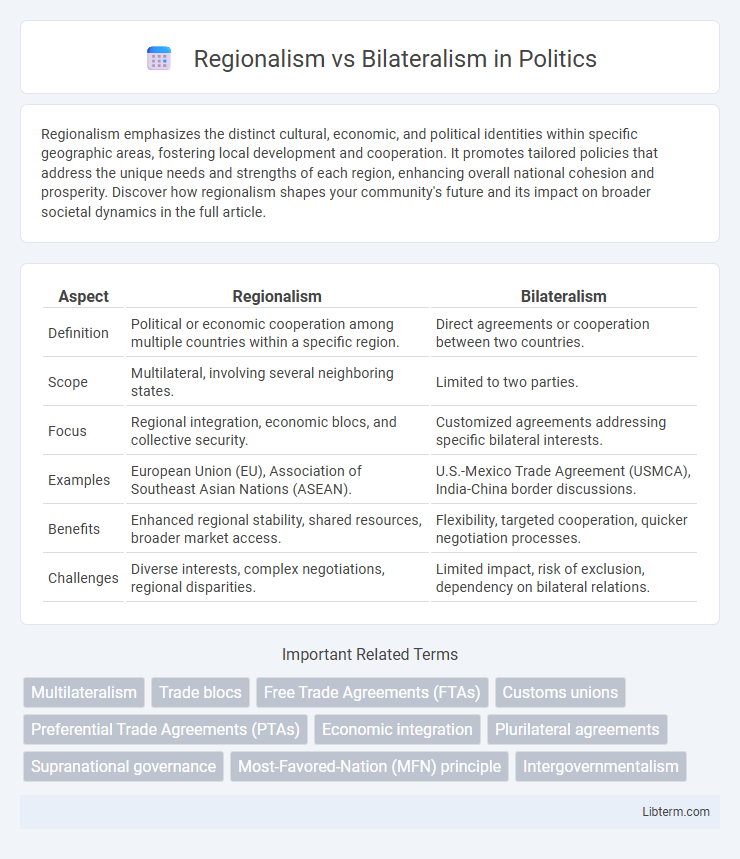Regionalism emphasizes the distinct cultural, economic, and political identities within specific geographic areas, fostering local development and cooperation. It promotes tailored policies that address the unique needs and strengths of each region, enhancing overall national cohesion and prosperity. Discover how regionalism shapes your community's future and its impact on broader societal dynamics in the full article.
Table of Comparison
| Aspect | Regionalism | Bilateralism |
|---|---|---|
| Definition | Political or economic cooperation among multiple countries within a specific region. | Direct agreements or cooperation between two countries. |
| Scope | Multilateral, involving several neighboring states. | Limited to two parties. |
| Focus | Regional integration, economic blocs, and collective security. | Customized agreements addressing specific bilateral interests. |
| Examples | European Union (EU), Association of Southeast Asian Nations (ASEAN). | U.S.-Mexico Trade Agreement (USMCA), India-China border discussions. |
| Benefits | Enhanced regional stability, shared resources, broader market access. | Flexibility, targeted cooperation, quicker negotiation processes. |
| Challenges | Diverse interests, complex negotiations, regional disparities. | Limited impact, risk of exclusion, dependency on bilateral relations. |
Introduction to Regionalism and Bilateralism
Regionalism emphasizes cooperation among multiple countries within a specific geographical area to foster economic integration, political collaboration, and social cohesion. Bilateralism revolves around direct agreements between two nations, aiming to enhance trade, security, and diplomatic relations through tailored partnerships. Both frameworks shape global governance by addressing distinct scopes and objectives in international relations and economic policies.
Defining Regionalism: Key Features and Examples
Regionalism involves countries within a specific geographic area collaborating to enhance economic, political, or social ties through agreements like free trade areas or customs unions. Key features include preferential trade policies, shared regulatory standards, and coordinated economic strategies aimed at fostering regional integration and development. Prominent examples of regionalism include the European Union (EU), the Association of Southeast Asian Nations (ASEAN), and the Mercosur trade bloc in South America.
Understanding Bilateralism: Core Concepts and Cases
Bilateralism involves direct agreements between two states, emphasizing tailored cooperation on trade, security, and diplomatic matters without broader multilateral obligations. Key cases include the US-China Phase One trade deal, which targets specific tariffs and intellectual property issues, and the India-Australia Economic Cooperation and Trade Agreement, enhancing market access and investment flows. Core concepts highlight trust-building, reciprocity, and flexibility, allowing nations to address mutual interests efficiently outside complex regional frameworks.
Historical Evolution of Regional and Bilateral Agreements
Regionalism originated prominently in the post-World War II era with the formation of blocs such as the European Economic Community, emphasizing economic integration among neighboring states to promote stability and growth. In contrast, bilateralism gained momentum through tailored agreements like the U.S.-Canada Free Trade Agreement in 1988, focusing on direct, reciprocal trade benefits between two countries. The historical evolution reflects shifting priorities, where regionalism favored multilateral cooperation within geographic proximities, while bilateralism emphasized flexible, strategic partnerships adapting to specific national interests.
Economic Impacts: Regionalism vs Bilateralism
Regionalism fosters broader economic integration by creating large-scale trade blocs that enhance market access, encourage investment flows, and promote regulatory harmonization among multiple countries. Bilateralism, while offering tailored trade agreements between two nations with specific economic interests, may limit the scope of market expansion and reduce the potential for cross-border supply chain efficiencies. The economic impact of regionalism often leads to increased trade volume, diversified economic partnerships, and stronger collective bargaining power compared to the more constrained and potentially fragmented outcomes of bilateral agreements.
Political Implications in Global Trade Dynamics
Regionalism strengthens political alliances by promoting cooperation among neighboring countries, fostering shared regulatory standards and collective bargaining power in global trade negotiations. Bilateralism, however, enables tailored political agreements between two nations, allowing for strategic partnerships but potentially undermining multilateral frameworks and creating fragmented trade policies. The political implications of these approaches shape global trade dynamics by influencing power distribution, diplomatic relations, and the stability of international economic governance.
Regional Trade Blocs vs Bilateral Trade Agreements
Regional trade blocs, such as the European Union and ASEAN, promote economic integration by establishing common markets and harmonizing regulations among multiple countries, enhancing trade efficiency and political cooperation within a specific region. Bilateral trade agreements involve two countries negotiating terms to reduce tariffs and barriers, providing tailored benefits but potentially creating complexity due to overlapping rules with other agreements. The choice between regionalism and bilateralism affects trade flows, market access, and the strategic positioning of countries in global trade networks.
Advantages and Disadvantages of Each Approach
Regionalism promotes economic integration among geographically proximate countries, offering advantages such as reduced trade barriers, enhanced political cooperation, and collective bargaining power, but faces challenges like complex regulatory harmonization and exclusion of non-member states. Bilateralism enables tailored agreements between two countries, allowing for flexible, specific arrangements and faster negotiations, though it may result in overlapping rules and limited broader market access. Both approaches impact global trade patterns, with regionalism fostering multilateral collaboration within a region and bilateralism emphasizing direct partnerships that can complicate global trade networks.
Contemporary Trends and Future Prospects
Contemporary trends reveal a shift towards regionalism characterized by large-scale trade agreements such as the Regional Comprehensive Economic Partnership (RCEP) and the African Continental Free Trade Area (AfCFTA), which promote economic integration among multiple countries to enhance cooperation and market access. Bilateralism continues to hold significance with targeted trade deals like the US-Mexico-Canada Agreement (USMCA) addressing specific economic and strategic interests between two nations. Future prospects suggest a hybrid approach where regional frameworks provide broad collaboration platforms, while bilateral agreements fine-tune relationships amidst geopolitical complexities and shifting global trade dynamics.
Conclusion: Choosing the Optimal Path
Regionalism, characterized by multilateral agreements among geographically proximate countries, fosters economic integration and political cooperation on a broader scale. Bilateralism emphasizes direct partnerships that offer tailored agreements and quicker implementation but may lack the extensive benefits of regional frameworks. Choosing the optimal path depends on strategic goals, with regionalism benefiting comprehensive market access and bilateralism providing targeted, flexible solutions.
Regionalism Infographic

 libterm.com
libterm.com